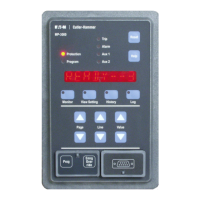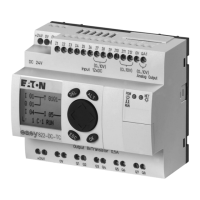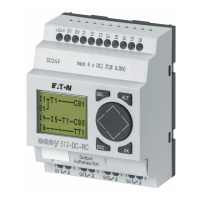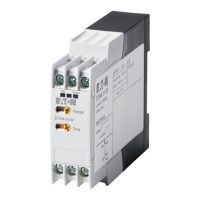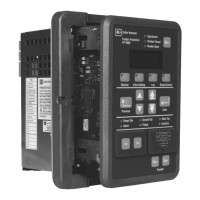www.eaton.com Page 8-1
MP-4000
IB02602002E
SECTION 8 - MOTOR THERMAL PROTECTION BASICS
8.0 General
This section describes how the MP-4000 hardware and software func-
tion together to control, monitor, and protect the motor.
8.1 Sensing Inputs
The MP-4000 receives motor phase currents from three main motor
phase current transformers (see Figure 8-1). If an optional ground
fault transformer is used, the MP-4000 monitors ground leakage or
fault current as well.
The MP-4000 takes 36 samples per power cycle of the input current
signals, digitizes each sample, and stores it in the microproces-
sor memory. From these samples, the MP-4000 computes RMS
currents and average currents. It also performs phasor calculations
leading to direct and precise measurement of positive and negative
sequence currents. Refer to Subsection 8.2 for further details. The
high sampling rate, plus a unique patented sample-shifting technique,
allows the MP-4000 to properly measure and account for the impact of
harmonics in heating the motor.
The MP-4000 receives motor phase voltages from three motor phase
power transformers. The MP-4000 takes 36 samples per power cycle.
From these samples, the MP-4000 calculates RMS and average
voltages. The MP-4000 also performs phase calculations that allow
precise measurement of positive and negative sequence voltages,
power factor, and power.
If the optional URTD module is used, the MP-4000 gathers winding
temperature data from up to six resistance temperature detectors
(RTDs) embedded in the stator windings of the motor. It can monitor
four RTDs associated with the motor bearings and load bearings. It
can also monitor one auxiliary RTD, such as motor case temperature.
8.2 Protective Functions
Protective functions continuously monitor motor operating conditions,
such as current history and temperature. When measured or derived
measurements exceed User-selected levels, an alarm condition is
initiated, and then, if necessary, a trip output opens the motor contac-
tor or trips a breaker.
The MP-4000 can protect the motor, starter, and load in the following
ways:
Stator and rotor thermal protection by modeling of heating
and cooling effects, including heating by negative sequence
currents;
Stator over temperature protection by direct measurement
(with optional URTD module);
Instantaneous over current protection for faults;
Ground fault protection;
Phase reversal protection;
Phase unbalance protection;
Motor bearing, load bearing, and auxiliary RTD temperature
protection (with optional URTD module);
Jam protection;
Underload protection;
Transition trip for abnormal starting time-versus-current
behavior;
•
•
•
•
•
•
•
•
•
•
Incomplete sequence protection (missing status feedback
from load or starter);
Trip-bypass output for failure of contactor to interrupt current
after a trip command;
Zero speed switch stalled-motor trip protection;
Process load shedding function to forestall impending jam or
thermal trips; and
Jogging protection - minimum time between starts, maximum
number of starts per set time, maximum number of consecu-
tive cold starts, and minimum time between stop and start
(anti-backspin protection).
Many of these functions also have separate alarm thresholds to warn
the User, who may be able to act before a trip occurs.
The MP-4000 has four output relays. The Trip relay is connected in se-
ries with the motor contactor and de-energizes the contactor or blocks
motor starting for any MP-4000 trip condition. All trips are steered to
this relay.
The three other relays are designated as Alarm, Auxiliary 1, and Aux-
iliary 2. Normally, all alarm and warning conditions are steered to the
Alarm relay. However, the Alarm relay and the two Auxiliary relays are
all fully programmable. They can be set by the User to operate for a
designated list of internal MP-4000 measured or calculated conditions.
8.2.1 Direct Load-Based Protection
The monitored level of actual motor current is used to determine when
the instantaneous over current trip, jam trip, load shedding, underload
trip, transition trip, and load-shedding settings have been reached.
Also, direct temperature feedback from the stator, load bearing, motor
bearing, and auxiliary RTDs are compared with respective settings. If
necessary, the relay gives alarm and/or trip outputs.
8.2.2 Thermal Model and Rotor Temperature Protection
Each motor has a specic damage curve. Usually it is called the I
2
t (current squared multiplied by time) curve. With larger horsepower
motors, the thermal capability is usually rotor-limited, so it is important
to track the total heating of the rotor. In ac motors, the current balance
between phases is of major concern due to the additional rotor heating
associated with the negative sequence component of an unbalanced
phase current condition. Current unbalance is usually caused by
voltage unbalance, the result of single-phase loads on a three-phase
system, and/or motor winding unbalance.
Any unbalanced set of three-phase currents or voltages can be math-
ematically transformed into a linear combination of positive, negative,
and zero sequence components. The measured current phasor in
each phase is the sum of the three sequence component phasors
in that phase. The zero sequence component is a common mode
component which is equal in the three phases, and requires a neutral
or ground path for return. So, in a motor without a neutral return, no
zero sequence current is seen unless there is a ground fault. Thus, the
focus is on the positive and negative sequence components that can
routinely be present.
For analysis and understanding, consider the motor to have two
tandem virtual rotors as shown in Figure 8.2. One is driven only by
the positive sequence current I
1
, which is symmetrical and balanced.
The other is driven only by counter-rotating negative sequence current
I
2
, directly related to unbalanced current, and produces a proportional
torque in the reverse direction. If perfect current balance and phase
angle symmetry exists among the three phases, I
1
would be the only
component of line current squared, with no effect from the second ro-
tor. This positive sequence component of current produces the motor
output torque and work.
•
•
•
•
•
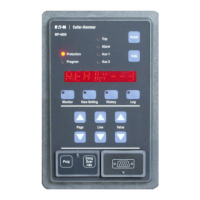
